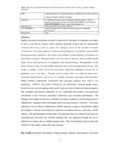Higher Education Curriculum Orientation and Performance of Universities in Kenya: Industry Linkage Strategies
Abstract
Quality education and training can only be achieved by orienting the academic curriculum
in such a way that its content reflects industry demands. It must also be continuously
reviewed after every cycle to capture the emerging issues in the dynamic economic
environment. This study sought to contribute to knowledge by assessing the extent to which
linking university curricula to the needs of the industry would influence performance of
universities in Kenya. Resource based view was used as the main theory anchoring the
study. Cross-Sectional survey was adopted as the research design. The population of the
study consists of sixty five (65) public and private universities incorporated in Kenya. Out
of this, a sample of forty seven (47) universities which had undergone at least one (1)
graduation cycle was taken. Primary and secondary data was collected using semi
structured questionnaires and review of existing university documents and regulatory
bodies websites respectively. Correlation and regression analyses were used to test
hypotheses. ANOVA was used to determine the differences between group means.
Balanced score card was appropriately used to represent financial and non-financial aspects
that constitute performance indicators. It was established that positive and significant
correlations existed between curriculum orientation and university performance. The
findings offer insight to university authorities and policy makers by reinforcing the role of
collaborative strategies when developing and reviewing academic curricula. University
authorities need to enhance collaboration with the industry in order to substantially exploit
the synergies resulting from enhanced symbiotic correlations between university and the
industry. The main limitation of this study is that primary data was collected from only one
respondent per university but common methods bias was mitigated through the use of
additional secondary data to validate primary data. Thus, the limitation did not affect the
credence of the results as presented and discussed

